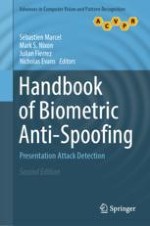This authoritative and comprehensive handbook is the definitive work on the current state of the art of Biometric Presentation Attack Detection (PAD) – also known as Biometric Anti-Spoofing. Building on the success of the previous, pioneering edition, this thoroughly updated second edition has been considerably expanded to provide even greater coverage of PAD methods, spanning biometrics systems based on face, fingerprint, iris, voice, vein, and signature recognition. New material is also included on major PAD competitions, important databases for research, and on the impact of recent international legislation. Valuable insights are supplied by a selection of leading experts in the field, complete with results from reproducible research, supported by source code and further information available at an associated website.
Topics and features: reviews the latest developments in PAD for fingerprint biometrics, covering optical coherence tomography (OCT) technology, and issues of interoperability; examines methods for PAD in iris recognition systems, and the application of stimulated pupillary light reflex for this purpose; discusses advancements in PAD methods for face recognition-based biometrics, such as research on 3D facial masks and remote photoplethysmography (rPPG); presents a survey of PAD for automatic speaker recognition (ASV), including the use of convolutional neural networks (CNNs), and an overview of relevant databases; describes the results yielded by key competitions on fingerprint liveness detection, iris liveness detection, and software-based face anti-spoofing; provides analyses of PAD in fingervein recognition, online handwritten signature verification, and in biometric technologies on mobile devicesincludes coverage of international standards, the E.U. PSDII and GDPR directives, and on different perspectives on presentation attack evaluation.
This text/reference is essential reading for anyone involved in biometric identity verification, be they students, researchers, practitioners, engineers, or technology consultants. Those new to the field will also benefit from a number of introductory chapters, outlining the basics for the most important biometrics.
